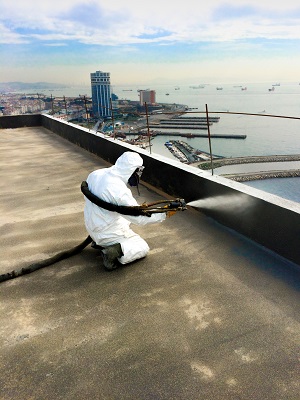Waterproofing solutions for commercial construction projects come in a variety of materials or chemical make-ups. They range from the asphalt-based products of traditional solutions to advanced technologies such as polyurethane, PMMA (polymethylmethacrylate), and polyurea.
Liquid-applied waterproofing is a popular solution for horizontal deck applications, and this application is evolving as technologies improve and a wider variety of systems and manufacturers populate the category. There are hot-applied liquid waterproofing solutions made of vulcanized rubber, such as hot rubberized asphalt (HRA), and cold-applied liquid waterproofing solutions made of polymers, such as thermoplastic elastomers.
An elastomeric waterproofing material offers advantages over other types of technologies due to its flexibility to expand and contract; its durability, which prevents punctures, indentations, and abrasions; and its ability to withstand high tensile forces. Because of the demands made on waterproofed surfaces in commercial building and construction environments, it’s critical that the material chosen for a waterproofing project have elastomeric qualities.
Elastomeric materials, including coatings, are made out of an elastomer, which is a polymer that has elastic properties similar to natural rubber. A liquid waterproofing solution that is elastomeric is highly flexible, and it can provide four pertinent waterproofing advantages.
1. Crack Bridging
Having the ability to expand and contract allows an elastomeric waterproofing material to accommodate the structural movements of a building or a surface. This quality also helps to bridge cracks that may have been caused by concrete shrinkage.
Crack bridging is essential with liquid waterproofing materials due to the natural dynamic movement of buildings and structures. Movement creates cracks. In climates with greater temperature changes from season to season, especially those that go down to low ambient temperatures, there is a propensity for these cracks to shift, open, and close. This back-and-forth movement of cracks as temperatures change can create frequent fatigue cycles for the waterproofing membrane — year after year.
An elastomeric, cold-applied liquid waterproofing membrane is able to withstand building movements and fatigue cycles, maintaining its integrity over a long period of time and protecting the structure underneath by preventing any water intrusion.
2. Damage Resistance
The durability of the waterproofing materials includes the resistance to punctures, indentations, and abrasions, and the ability to withstand tensile and other mechanical forces. This characteristic should be a major consideration when choosing a liquid waterproofing solution.
There are specific criteria that should be assessed to determine a coating’s durability:
● Tear resistance or tear strength: The resistance to tearing action, including the force to initiate tearing of the materials or tear propagation. With a waterproofing application, the high force required to initiate the tearing is particularly important to prevent breach formation.
● Shore hardness: The resistance of a material to indentation and heavy loads.
● Abrasion resistance: The ability to handle numerous cycles of abrasion on the surface before wearing down or rubbing away by means of friction.
 Most elastomeric, cold-applied liquid waterproofing solutions are systems made up of ingredients that can react to form a high molecular weight or cross-linking polymer, providing strong resistance to puncture, indentation, wear and tear, etc. Exposed waterproofing or the waterproofing protection course should stand up to any foot traffic or construction activity. This is especially critical when heavy equipment is moved, rested, or even dropped on the surface, which may break the concrete underneath.
Most elastomeric, cold-applied liquid waterproofing solutions are systems made up of ingredients that can react to form a high molecular weight or cross-linking polymer, providing strong resistance to puncture, indentation, wear and tear, etc. Exposed waterproofing or the waterproofing protection course should stand up to any foot traffic or construction activity. This is especially critical when heavy equipment is moved, rested, or even dropped on the surface, which may break the concrete underneath.
The reactive, elastomeric, cold-applied liquid waterproofing also gives it the ability to handle “point loads,” such as from a heavy piece of equipment with narrow legs underneath. In such an instance, the membrane will not show a dent or penetration. Up to a 3,000-psi (20.7 MPa) point load has been tested on elastomeric, cold-applied liquid waterproofing without causing a single dent on the membrane.
3. Elongation Capabilities
An elastomeric, cold-applied liquid waterproofing solution’s flexibility combined with its tensile strength enables it to withstand stretching beyond the point where other (particularly hot-applied) liquid waterproofing solutions might break. This is just by nature of being an elastomeric; it comes with the very science of the coating.
4. Fewer Steps
As a result of its elastomeric qualities, cold-applied liquid waterproofing requires only one to two layers to achieve reliable and durable performance. The use of an inter-layer reinforcement is also not required to maintain the integrity of the waterproofing membrane. Additionally, a protection course is not necessary during construction when using an elastomeric coating, which helps to reduce the complexity of and, therefore, potential for errors during installation.
Conclusion
Liquid waterproofing solutions must have certain characteristics to perform effectively — specifically flexibility and durability. Solutions containing polymers that are elastomeric provide flexibility and strength that ensure the system has durability, enabling performance that is critical to long-lasting waterproofing and protection of the roofing substrate. An elastomeric waterproofing material is physically tough enough to handle construction site abuse and long-term aging while maintaining its waterproofing integrity.